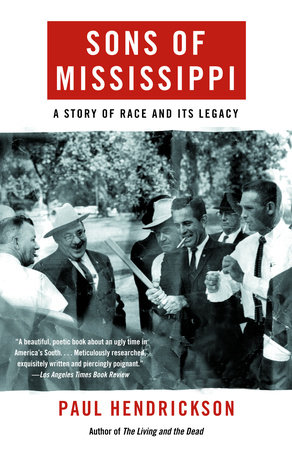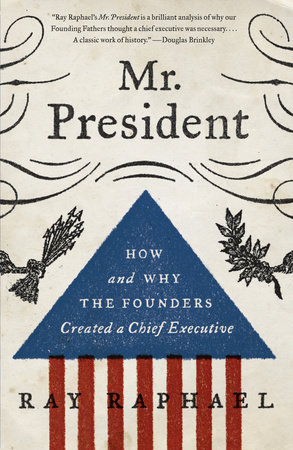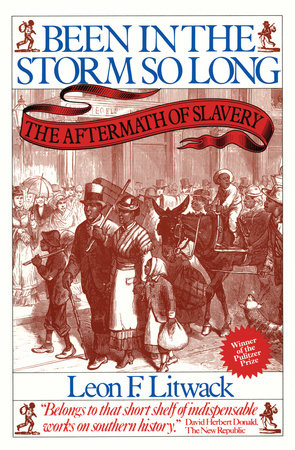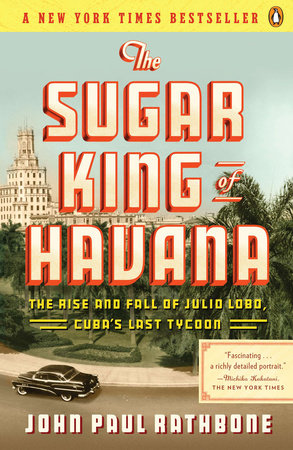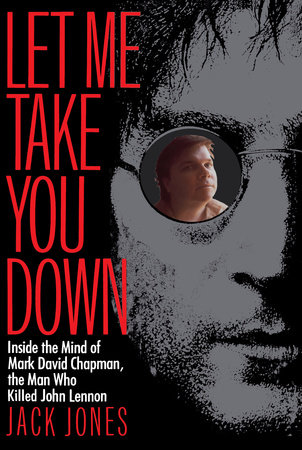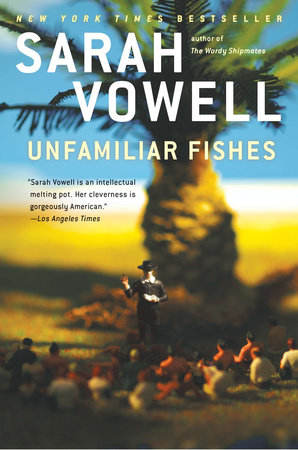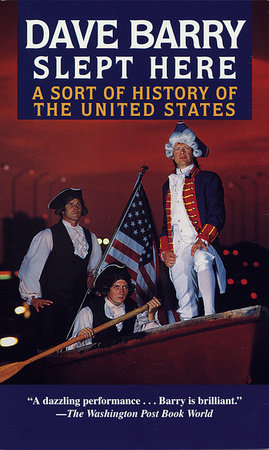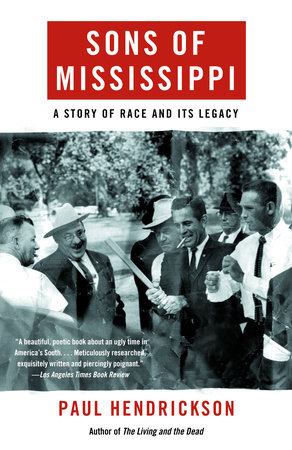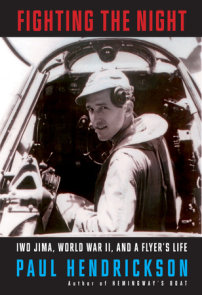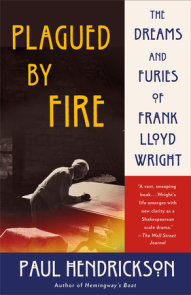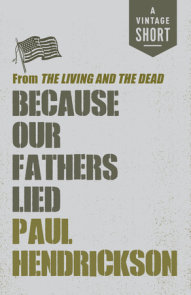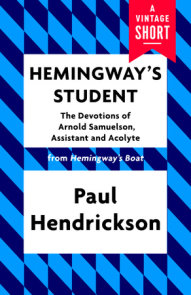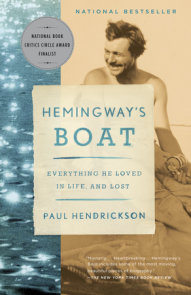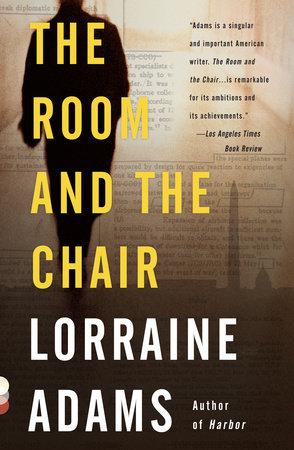Author Q&A
A Conversation with Paul Hendrickson
Q: The idea for Sons of Mississippi came from a photograph you found while browsing in a bookstore. Of all the images that could have caught your attention, what exactly was it about Charles Moore’s 1962 photo of seven Mississippi sheriffs that captivated you?
A: Even now it’s difficult to say. I’ve always thought books find us, rather than we them. The picture, which was in an anthology of Charles Moore’s work entitled Powerful Days, triggered the journey. There was something about the angles of cigarettes, and middle-aged men in white shirts and ties, and an armband that almost could have been a tourniquet. Something about a strange-looking priest (he had a club) and his profane deacons (they were laughing so nastily), semi-circled around an altar or maybe it was the lid of a gleaming coffin (actually, it was the barely visible hood of a squad car), as they readied for their satanic rites.
My imagination took off. I had nothing but a black and white image in my hand that was forty years old, but something was born. There were other things working, too, in my psyche, even autobiographical tensions. It took a lot of years, and a lot of reporting, and a lot of thinking, to begin to understand all that.
Q: Although the photo that inspired the book was taken a few days before James Meredith forced the integration of the University of Mississippi, in the prologue you focus on the story of Emmett Till, who was murdered in Mississippi seven years earlier. Why begin there? What connections did you find between Till and Meredith?
A: What I began to discover in my reporting trips to Mississippi was that the murder and mystery of Emmett Till touches every story about race in Mississippi, ends up—in some spiritual, homing way, in a little town called Money, at the foot of a falling-down and long-abandoned grocery store, where 14-year-old Till supposedly wolf-whistled at a white woman on a late August evening in 1955. So the book had to start there, with some recapitulation of the Till story, no matter how many times it has been told in other books. The Till story frames my tale, but the connection is more than just figurative. What I discovered, to my surprise and strange gratitude, was that there were direct links to some of the faces in that photograph: most notably with the sheriff at the far right of the picture, whose face you cannot see. In 1955 he was a deputy sheriff and he helped fish Till’s bloated corpse out of the Tallahatchie River. Indeed, in examining his own role in the Till story, I was able to come to terms with this sheriff’s character in ways I might not otherwise have been able to do.
Q: What obstacles did you face in tracking down the sheriffs and, more importantly, in getting them and their families to talk with you? How did they react to the stranger knocking on their doors and wanting to tell their stories?
A: Very few people turned me away. I was the stranger at the door and usually they beckoned me in. This is another of the paradoxes of Mississippi: a place with so appalling a racial history and a people of such charm and natural disposition to kindness. Sometimes I made my approach by letter or phone call; other times I just swallowed my spit and went up and knocked on the door. As a reporter I’ve had to face the terror of this many times. You just do it. You somehow overcome your awkwardness and fear. I never put myself in knowing
danger—going somewhere at night, for instance, that I wasn’t sure of. I will also say that in a story like this you work with those who are willing, and you quickly abandon any idea of trying to get interviews with those who aren’t inclined.
Two sheriffs were living when I began. Since the heart of the book has to do with the generations down from those faces, I had, in most cases, many possible people to contact: sons, grandsons, other relatives. You keep contacting people, you tell them as honestly as you are able what you are seeking to do—without necessarily telling them every blessed thing—and if they say, yes, come in, well, you’re off to the races. What I told them was that this was a book trying to come to terms with what had been passed down to succeeding generations from segregationist forebears. They were able to hear that and, in most cases, not turn away from the idea. Once a certain trust is won, the harder questions can start to be asked. When I first began, I had no idea anyone would talk to me. A historian and folklorist and native Mississippian at the University of Mississippi, William Ferris, said: “Oh, yes, they will. They want to talk to you. They’ve been waiting for you to show up.”
Q: In the hundreds of interviews you conducted, were there moments that particularly surprised or even shocked you?
A: There were surprises at every stop in the way—positive ones and bracing ones and very depressing ones. They are too many to name. You just go and try to have your mind and heart open to the experience. Ridding yourself of preconceptions is one of the difficult things.
Q: You studied for the missionary priesthood from 1958 to 1965 at a seminary in Holy Trinity, Alabama. How has that experience (the faith, the discipline, the geography, the culture) informed your writing, especially in this book?
A: I think all of it loops around. A 14-year-old Chicago boy—the same age that Emmett Till was when he went to Mississippi and never returned—named Paul Hendrickson got off a train in the Deep South of Alabama in the fall of 1958. There, in the terminal, were two water fountains side by side. One said, “White Only.” The other said, “Colored Only.” That was a rude moment in my sheltered consciousness. I had gone south to study for the Catholic Missionary. The civil rights movement was just opening. The world, in the late fifties, still felt pacific. We were behind cloistered seminary walls but we could hear the cracking sounds beyond those walls. So I was in the mysterious, fragrant, overhanging South—and you might say it was an experience I never got over. All these years later I found my way back to it in a story.
Q: "To me," James Meredith once wrote, "Mississippi is the most beautiful country in the world, during all seasons…. I feel love because I have always felt that Mississippi belonged to me and one must love what is his." Do the sons of Mississippi, the sons of the sheriffs as well as Meredith’s own, agree with this statement? Are they hopeful? Are you?
A: Despite everything that has happened in Mississippi, on that stained ground, there is something so appealing about the state. It is sometimes astonishingly beautiful, the way the land rolls, the way the cotton will stretch out forever in those white fields of late summer, the quality of the light, the intensity of the smells. The summer air can be sweet, vegetal, smoky, no matter that the heat is hitting you like a hammer. You’re in the Delta and the tree lines, if there are any trees, form a green filmy blur at the horizon. At night, it is so black, the stars pop out as if they were being punched through a vast cardboard set. What I am saying is that the land is magical. But you are also asking about “hope.”
Is there hope for the succeeding generations? Yes and no. The answer seems provisional. It’s by stutters and starts. It’s a step ahead and half-step of falling backward. I see “blades of hope.” You have to water them, let the sun get on them, breathe toward and over them lovingly. Those blades are so susceptible to trampling and quick loss. But there is no question that the generations—two and three down from the faces in that photograph—are different from their forebears. There are real success stories. What I am left with, in all my travels and reporting to Mississippi, is this: a sense of fragile hope for race relations in the 21st century. I am not a “seer.” I do not have the “answers.” I went to Mississippi and tried to understand.
